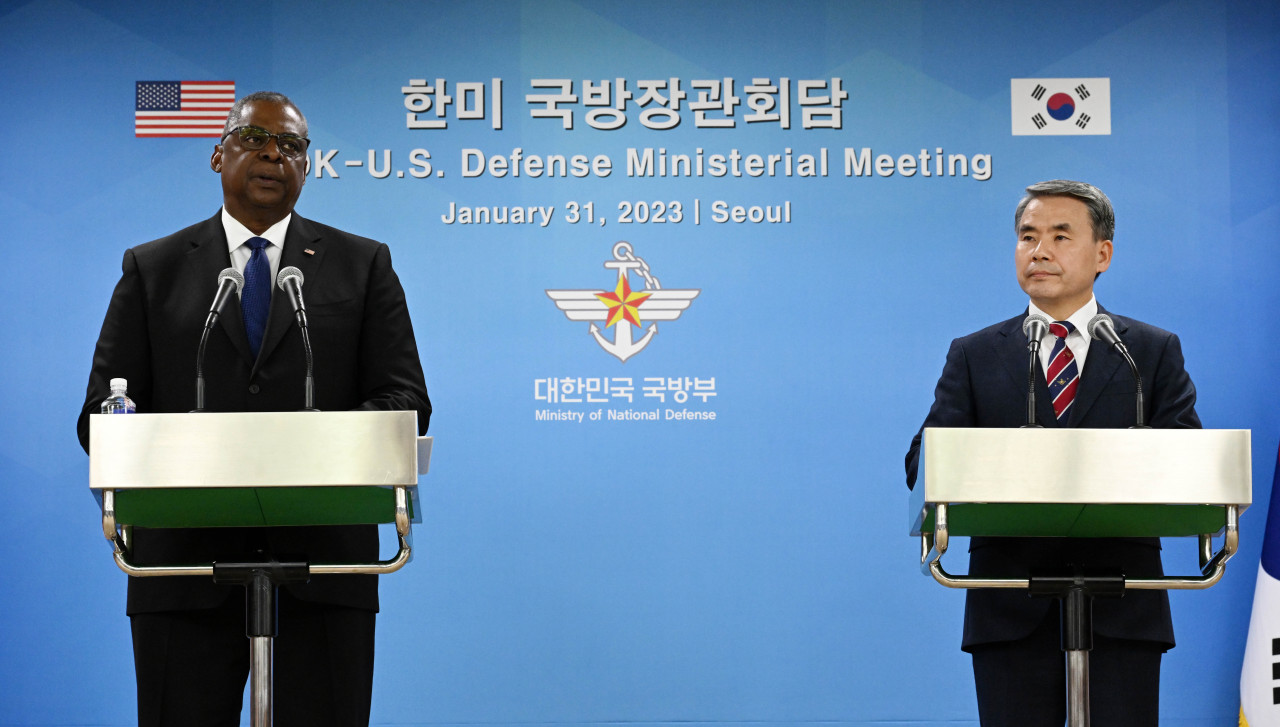
Austin and Lee “pledged to closely cooperate in order to continue to deploy US strategic assets in a timely and coordinated manner in the future,” a joint statement issued after the meeting said, citing US strategic bombers as an example.
At the meeting in Seoul, they discussed a wide range of ways to enhance the alliance’s deterrence and readiness posture against North Korea.
“Secretary Austin and I agreed to further expand and bolster the scale and level of combined exercises and training to establish peace through strength on the Korean Peninsula,” Lee told reporters at a press conference following the meeting.
The two countries also agreed to expand combined field training exercises and to conduct a large-scale combined joint firing demonstration to strengthen the alliance’s capabilities and readiness for our combined defense posture this year, Lee added.
The defense leaders reached the agreement in light of changes in the security environment, including North Korea's “recent steps with respect to its nuclear and missile programs,” according to the joint statement.
Austin and Lee also committed to taking specific measures to enhance the viability of US extended deterrence, which is the US’ commitment to deter or respond to coercion and external attacks on US allies and partners with the full range of its military capabilities, including nuclear weapons.
The defense chiefs pledged to enhance the alliance’s information sharing and consultation mechanisms on North Korean threats, as well as joint planning and execution on the alliance’s deterrence.
Seoul and Washington previously agreed to institutionalize a four-step specific mechanism during the last meeting in November to enable South Korea to play a bigger role and increase engagement in the multistage process to strengthen the viability of US extended deterrence against North Korea.
As part of these efforts, Seoul and Washington will also stage a discussion-based tabletop exercise, or TTX, led by the high-level Deterrence Strategy Committee in February to facilitate alliance discussions on deterrence and response options to deal with the North Korean nuclear threat, according to the statement.
The outcomes of the TTX will be reflected in the South Korea-US Tailored Deterrence Strategy, which Seoul and Washington agreed to update and revise before this year’s Security Consultative Meeting. The TDS is a strategic guideline on the alliance’s deterrence measures and response to better prepare for North Korea’s advancing nuclear and missile threats. However, it has yet to be updated since the allies first signed on in 2013.
Speaking at the press conference, Austin repeatedly underscored the US' unwavering commitment to extended deterrence as South Korea seeks more enhanced nuclear assurances from the US.
“The US commitment to the defense of Korea is ironclad. You’ve heard me say that a number of times. But that’s just not a slogan. It is what we’re all about,” Austin told reporters when asked about the ongoing nuclear policy debate in South Korea, including the development of its own nuclear weapons. “That commitment is ironclad and our extended deterrence is at the heart of that commitment,” Austin said.
During the meeting, they also discussed measures to enhance trilateral security cooperation among South Korea, the US and Japan and other regional security cooperation.
“The two leaders committed to following up on developing specific courses of action to facilitate trilateral sharing of missile warning data, as agreed by the three countries’ leaders at the November 2022 Phnom Penh Summit,” the statement read.
The three countries agreed to real-time information sharing to improve each country’s ability to detect and assess the threat posed by incoming missiles.
Lee and Austin also agreed to hold a meeting of the Defense Trilateral Talks “at the earliest opportunity” to discuss additional steps to step up trilateral information sharing and concrete measures on how to strengthen security cooperation.





